Attached files
| file | filename |
|---|---|
| 8-K - FORM 8-K - FTI CONSULTING, INC | d233013d8k.htm |
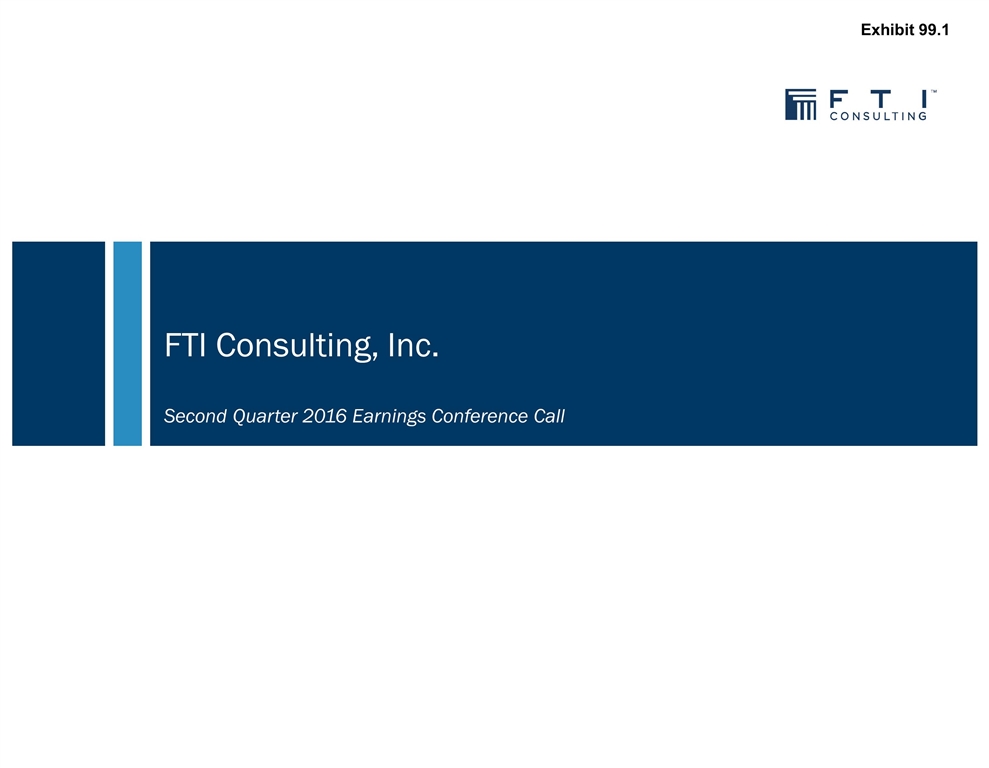
FTI Consulting, Inc. Second Quarter 2016 Earnings Conference Call Exhibit 99.1

Cautionary Note About Forward-Looking Statements This presentation includes "forward-looking statements" within the meaning of Section 27A of the Securities Act of 1933, as amended, and Section 21E of the Securities Exchange Act of 1934, as amended, which involve uncertainties and risks. Forward-looking statements include statements concerning our plans, objectives, goals, strategies, future events, future revenues, future results and performance, expectations, plans or intentions relating to acquisitions and other matters, business trends and other information that is not historical, including statements regarding estimates of our future financial results. When used in this presentation, words such as "anticipates," "estimates," "expects," “goals,” "intends," "believes,” "forecasts," “targets,” “objectives” and variations of such words or similar expressions are intended to identify forward-looking statements. All forward-looking statements, including, without limitation, estimates of our future financial results, are based upon our expectations at the time we make them and various assumptions. Our expectations, beliefs, projections and growth targets are expressed in good faith, and we believe there is a reasonable basis for them. However, there can be no assurance that management's expectations, beliefs, estimates or growth targets will be achieved, and the Company's actual results may differ materially from our expectations, beliefs, estimates and growth targets. The Company has experienced fluctuating revenues, operating income and cash flow in prior periods and expects that this will occur from time to time in the future. Other factors that could cause such differences include declines in demand for, or changes in, the mix of services and products that we offer, the mix of the geographic locations where our clients are located or where services are performed, adverse financial, real estate or other market and general economic conditions, which could impact each of our segments differently, the pace and timing of the consummation and integration of past and future acquisitions, the Company's ability to realize cost savings and efficiencies, competitive and general economic conditions, retention of staff and clients and other risks described under the heading "Item 1A Risk Factors" in the Company's most recent Form 10-K filed with the SEC and in the Company's other filings with the SEC, including the risks set forth under "Risks Related to Our Reportable Segments" and "Risks Related to Our Operations.” We are under no duty to update any of the forward-looking statements to conform such statements to actual results or events and do not intend to do so.

Today’s Speakers Steven Gunby President and Chief Executive Officer Catherine Freeman SVP, Controller and Chief Accounting Officer and Interim Chief Financial Officer
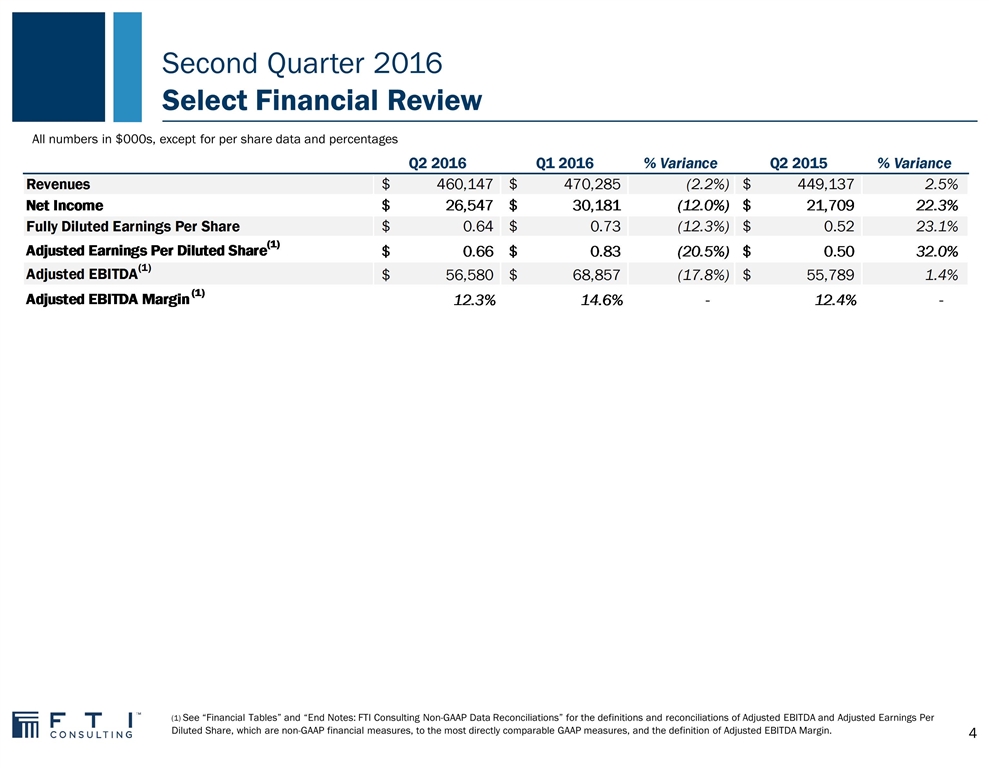
Second Quarter 2016 Select Financial Review All numbers in $000s, except for per share data and percentages (1) See “Financial Tables” and “End Notes: FTI Consulting Non-GAAP Data Reconciliations” for the definitions and reconciliations of Adjusted EBITDA and Adjusted Earnings Per Diluted Share, which are non-GAAP financial measures, to the most directly comparable GAAP measures, and the definition of Adjusted EBITDA Margin.

Second Quarter 2016 Select Segment Financial Review All numbers in $000s, except for percentages
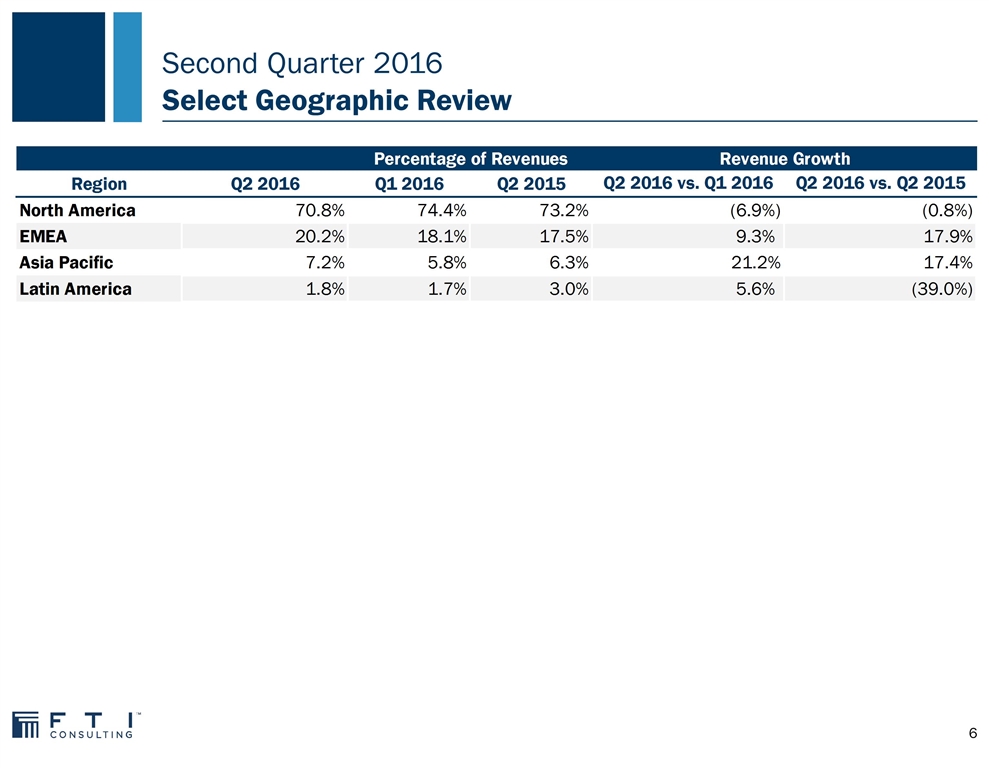
Second Quarter 2016 Select Geographic Review
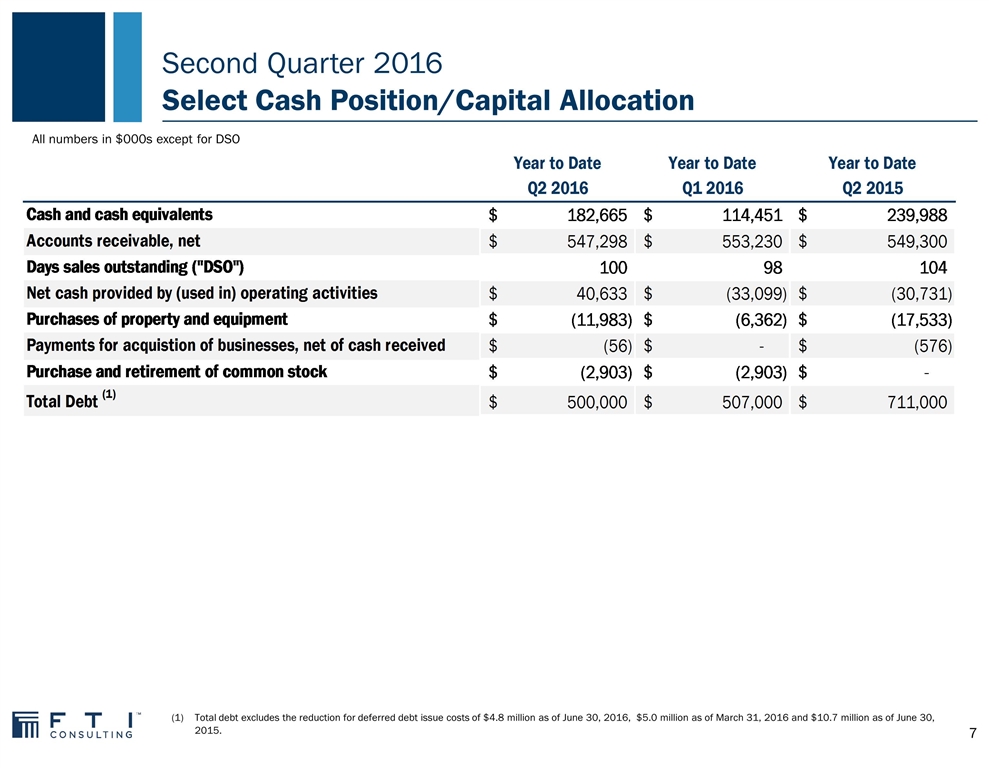
Second Quarter 2016 Select Cash Position/Capital Allocation All numbers in $000s except for DSO Total debt excludes the reduction for deferred debt issue costs of $4.8 million as of June 30, 2016, $5.0 million as of March 31, 2016 and $10.7 million as of June 30, 2015.
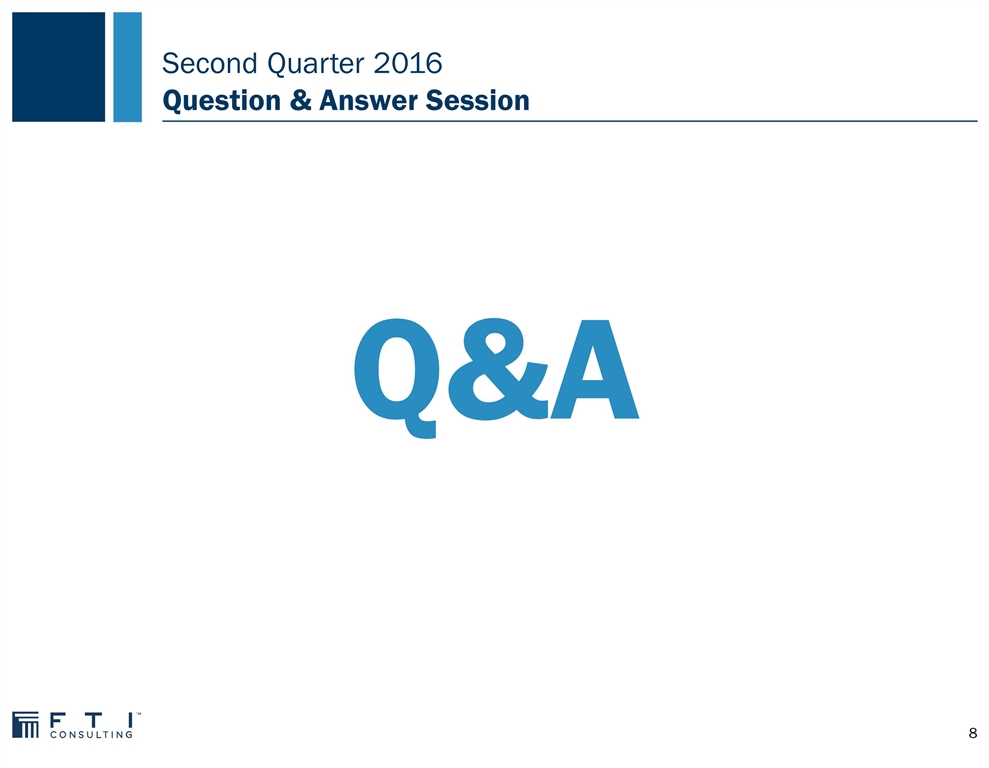
Second Quarter 2016 Question & Answer Session Q&A

Financial Tables
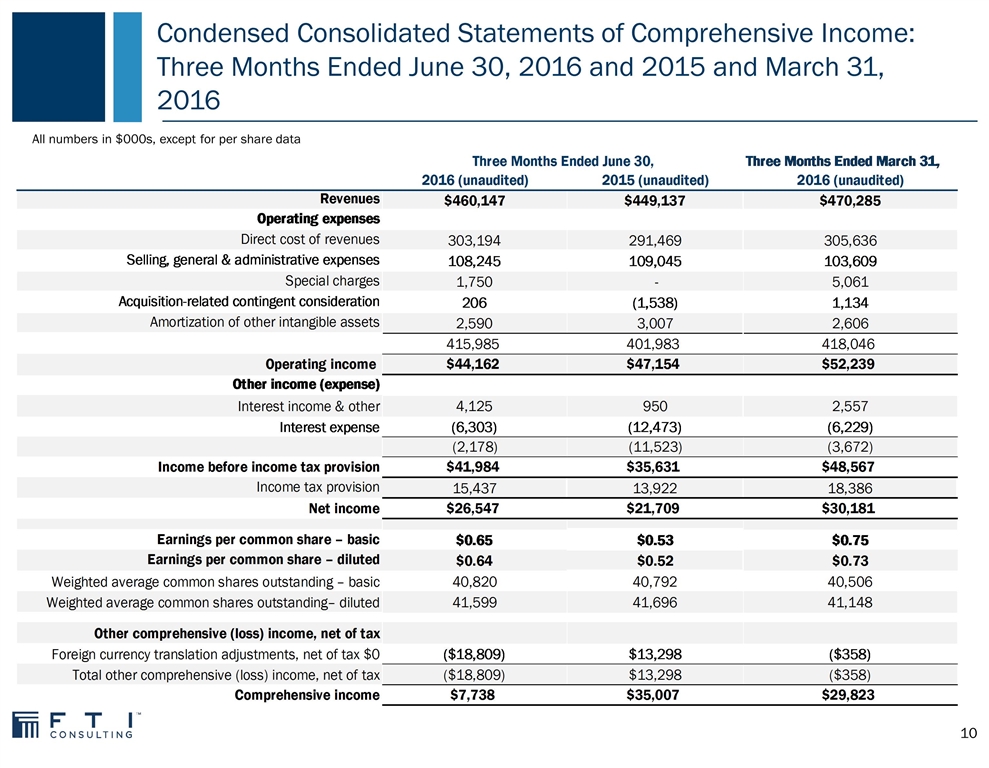
Condensed Consolidated Statements of Comprehensive Income: Three Months Ended June 30, 2016 and 2015 and March 31, 2016 All numbers in $000s, except for per share data
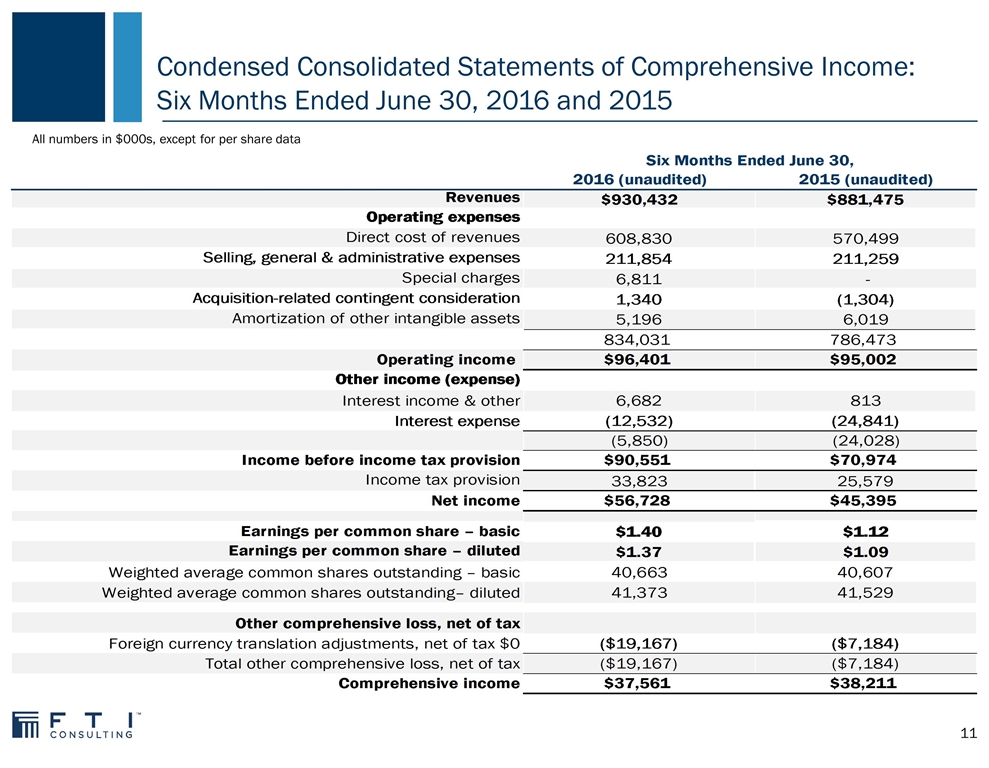
Condensed Consolidated Statements of Comprehensive Income: Six Months Ended June 30, 2016 and 2015 All numbers in $000s, except for per share data
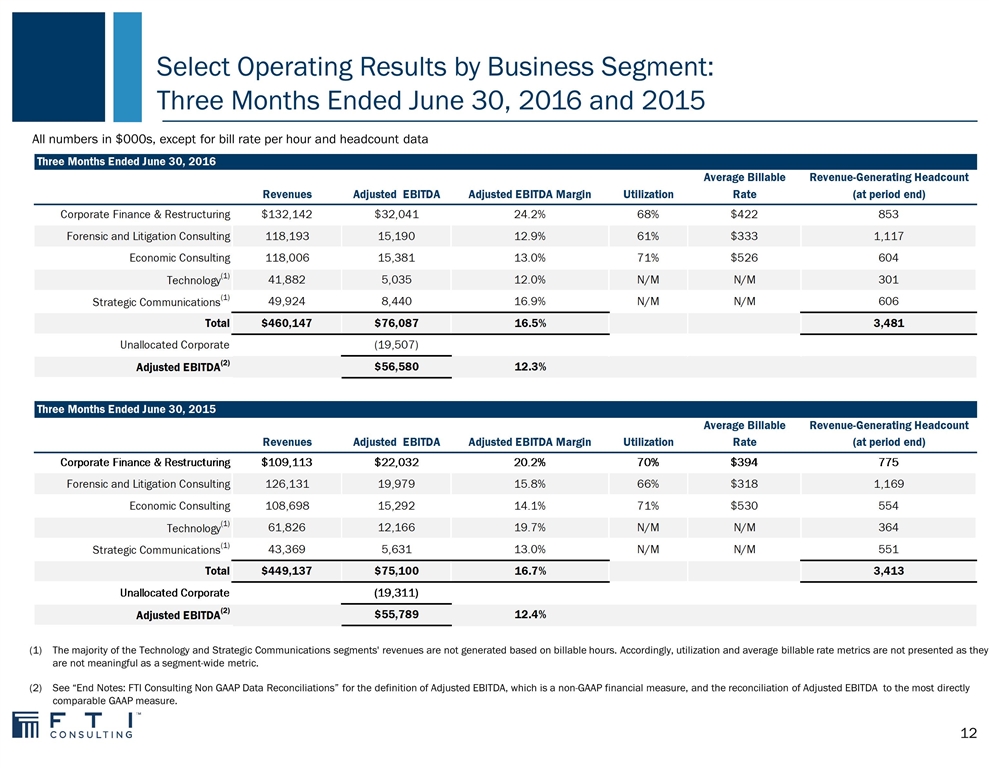
Select Operating Results by Business Segment: Three Months Ended June 30, 2016 and 2015 The majority of the Technology and Strategic Communications segments' revenues are not generated based on billable hours. Accordingly, utilization and average billable rate metrics are not presented as they are not meaningful as a segment-wide metric. See “End Notes: FTI Consulting Non GAAP Data Reconciliations” for the definition of Adjusted EBITDA, which is a non-GAAP financial measure, and the reconciliation of Adjusted EBITDA to the most directly comparable GAAP measure. All numbers in $000s, except for bill rate per hour and headcount data
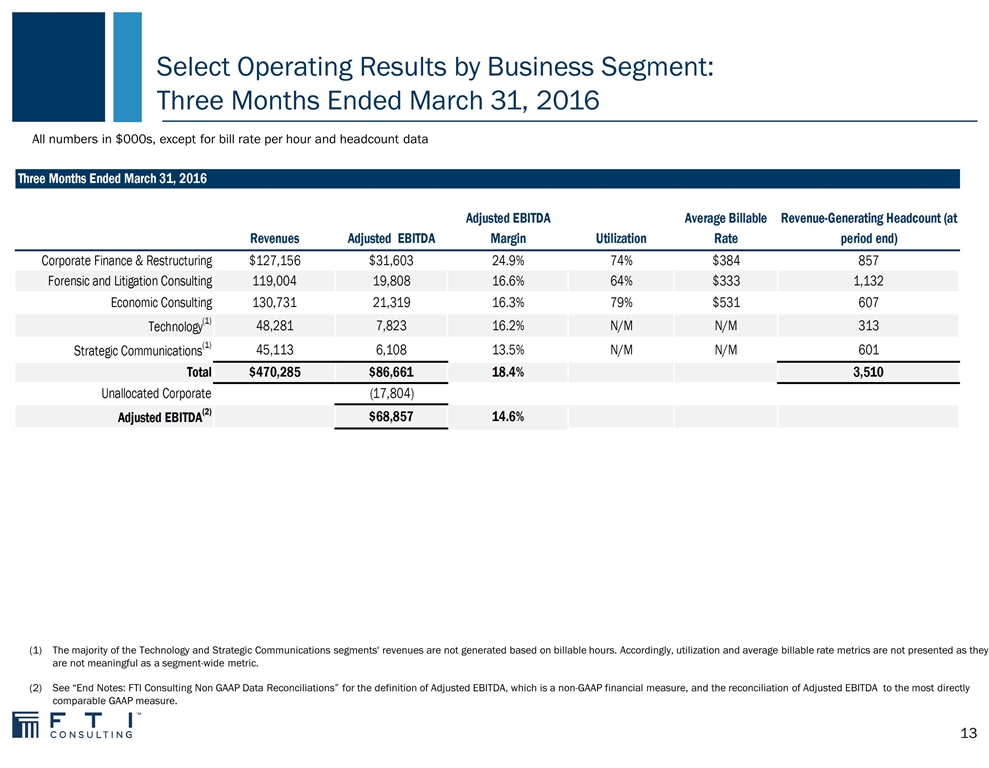
Select Operating Results by Business Segment: Three Months Ended March 31, 2016 All numbers in $000s, except for bill rate per hour and headcount data The majority of the Technology and Strategic Communications segments' revenues are not generated based on billable hours. Accordingly, utilization and average billable rate metrics are not presented as they are not meaningful as a segment-wide metric. See “End Notes: FTI Consulting Non GAAP Data Reconciliations” for the definition of Adjusted EBITDA, which is a non-GAAP financial measure, and the reconciliation of Adjusted EBITDA to the most directly comparable GAAP measure.
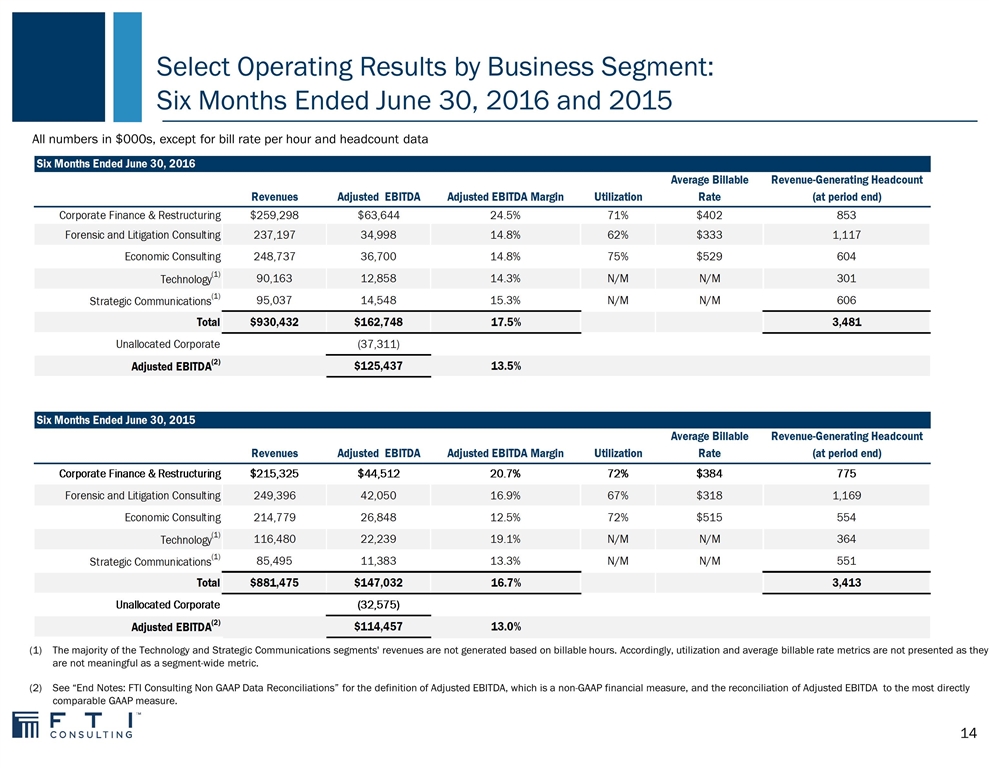
Select Operating Results by Business Segment: Six Months Ended June 30, 2016 and 2015 All numbers in $000s, except for bill rate per hour and headcount data The majority of the Technology and Strategic Communications segments' revenues are not generated based on billable hours. Accordingly, utilization and average billable rate metrics are not presented as they are not meaningful as a segment-wide metric. See “End Notes: FTI Consulting Non GAAP Data Reconciliations” for the definition of Adjusted EBITDA, which is a non-GAAP financial measure, and the reconciliation of Adjusted EBITDA to the most directly comparable GAAP measure.
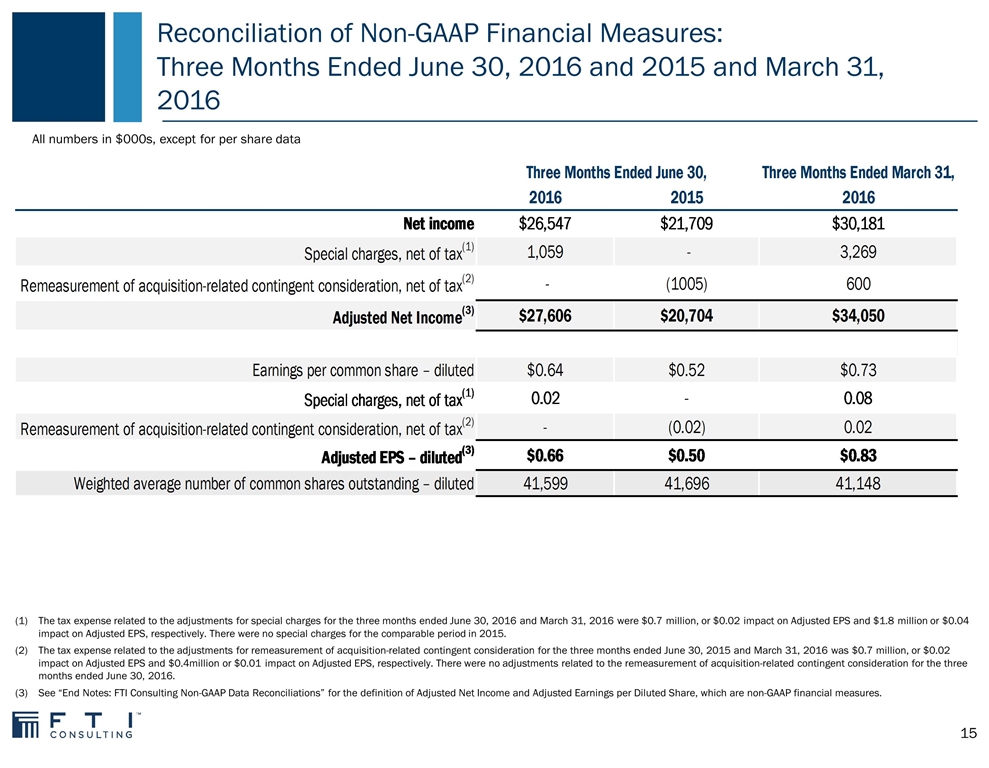
Reconciliation of Non-GAAP Financial Measures: Three Months Ended June 30, 2016 and 2015 and March 31, 2016 The tax expense related to the adjustments for special charges for the three months ended June 30, 2016 and March 31, 2016 were $0.7 million, or $0.02 impact on Adjusted EPS and $1.8 million or $0.04 impact on Adjusted EPS, respectively. There were no special charges for the comparable period in 2015. The tax expense related to the adjustments for remeasurement of acquisition-related contingent consideration for the three months ended June 30, 2015 and March 31, 2016 was $0.7 million, or $0.02 impact on Adjusted EPS and $0.4million or $0.01 impact on Adjusted EPS, respectively. There were no adjustments related to the remeasurement of acquisition-related contingent consideration for the three months ended June 30, 2016. See “End Notes: FTI Consulting Non-GAAP Data Reconciliations” for the definition of Adjusted Net Income and Adjusted Earnings per Diluted Share, which are non-GAAP financial measures. All numbers in $000s, except for per share data
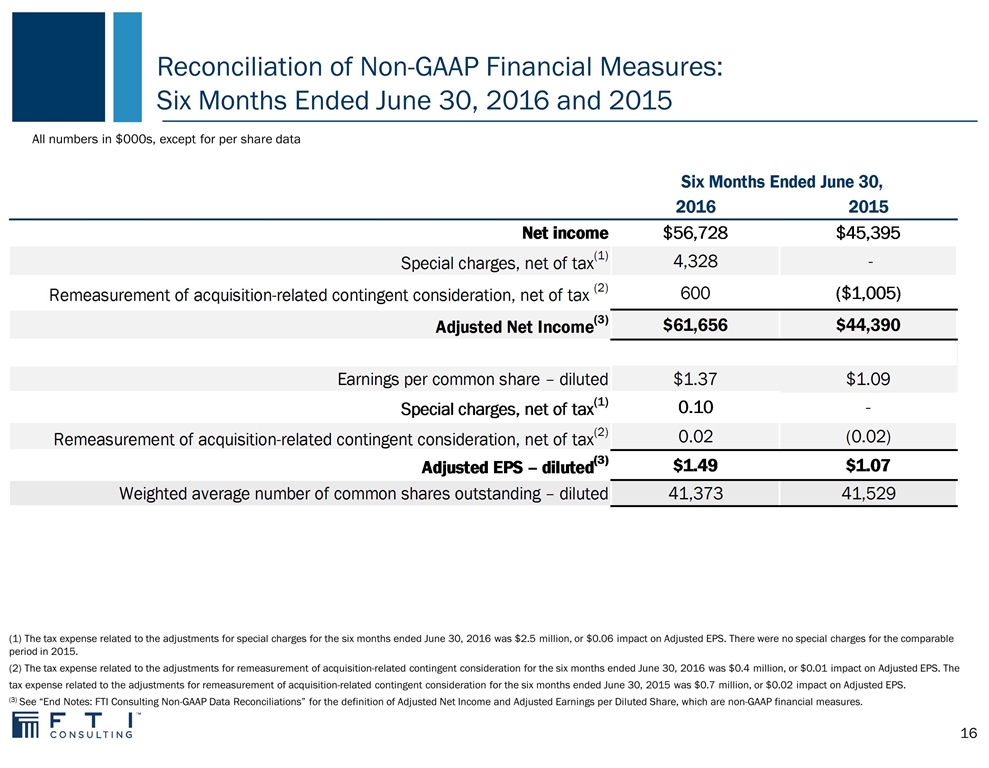
Reconciliation of Non-GAAP Financial Measures: Six Months Ended June 30, 2016 and 2015 (1) The tax expense related to the adjustments for special charges for the six months ended June 30, 2016 was $2.5 million, or $0.06 impact on Adjusted EPS. There were no special charges for the comparable period in 2015. (2) The tax expense related to the adjustments for remeasurement of acquisition-related contingent consideration for the six months ended June 30, 2016 was $0.4 million, or $0.01 impact on Adjusted EPS. The tax expense related to the adjustments for remeasurement of acquisition-related contingent consideration for the six months ended June 30, 2015 was $0.7 million, or $0.02 impact on Adjusted EPS. (3) See “End Notes: FTI Consulting Non-GAAP Data Reconciliations” for the definition of Adjusted Net Income and Adjusted Earnings per Diluted Share, which are non-GAAP financial measures. All numbers in $000s, except for per share data
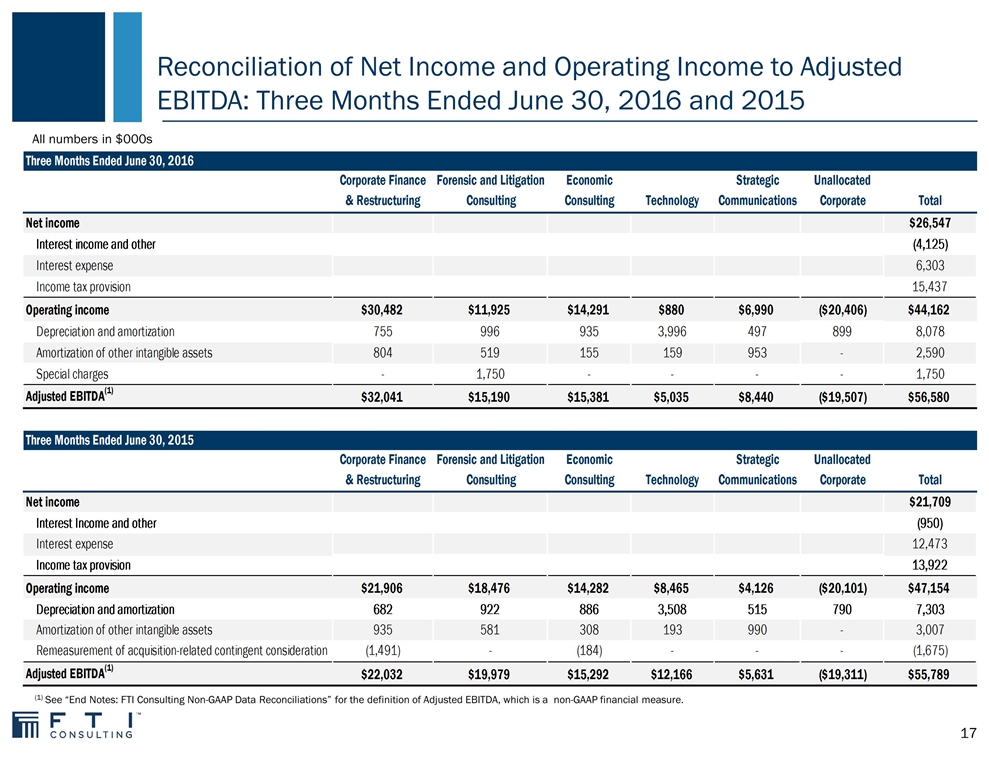
Reconciliation of Net Income and Operating Income to Adjusted EBITDA: Three Months Ended June 30, 2016 and 2015 (1) See “End Notes: FTI Consulting Non-GAAP Data Reconciliations” for the definition of Adjusted EBITDA, which is a non-GAAP financial measure. All numbers in $000s
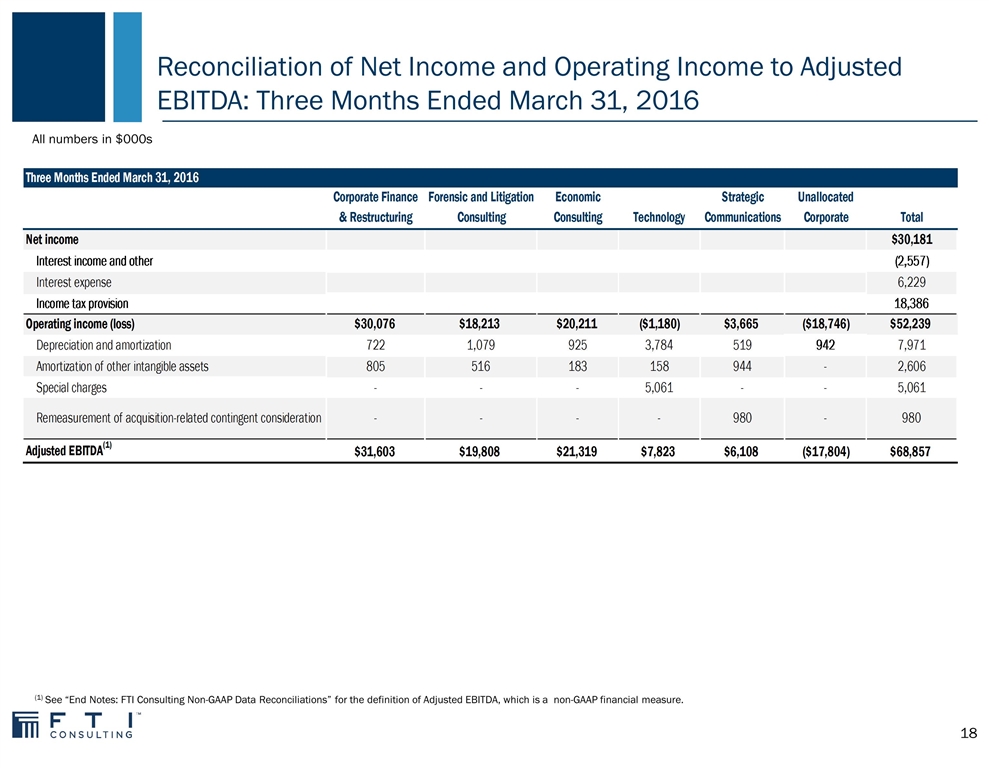
Reconciliation of Net Income and Operating Income to Adjusted EBITDA: Three Months Ended March 31, 2016 (1) See “End Notes: FTI Consulting Non-GAAP Data Reconciliations” for the definition of Adjusted EBITDA, which is a non-GAAP financial measure. All numbers in $000s
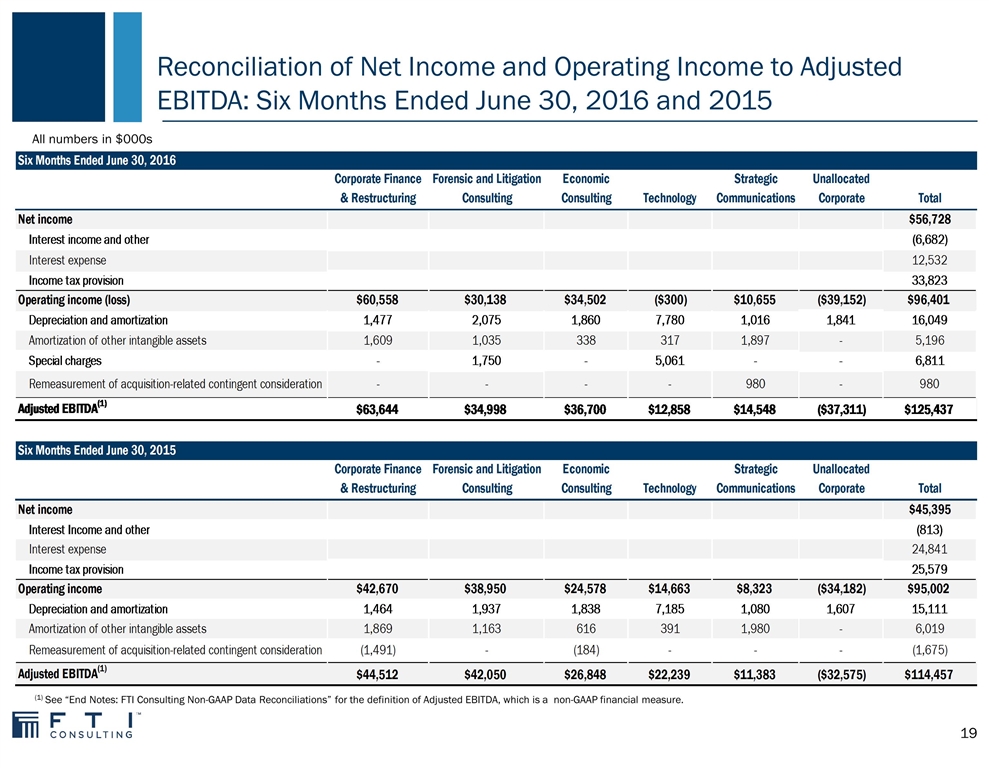
Reconciliation of Net Income and Operating Income to Adjusted EBITDA: Six Months Ended June 30, 2016 and 2015 (1) See “End Notes: FTI Consulting Non-GAAP Data Reconciliations” for the definition of Adjusted EBITDA, which is a non-GAAP financial measure. All numbers in $000s
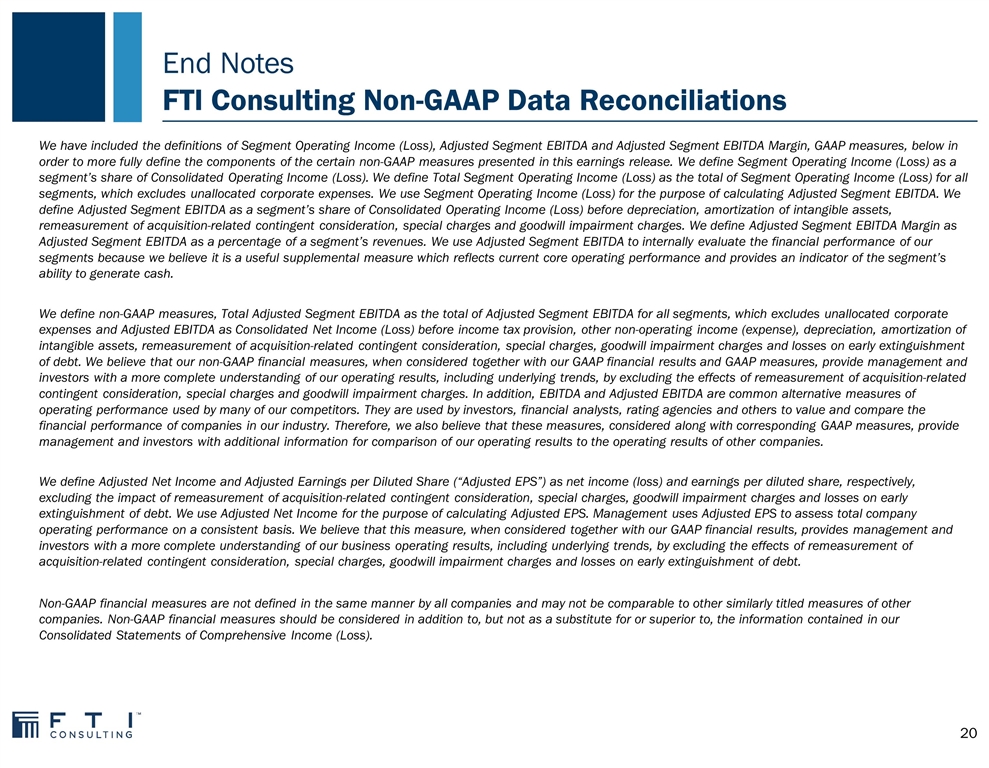
End Notes FTI Consulting Non-GAAP Data Reconciliations We have included the definitions of Segment Operating Income (Loss), Adjusted Segment EBITDA and Adjusted Segment EBITDA Margin, GAAP measures, below in order to more fully define the components of the certain non-GAAP measures presented in this earnings release. We define Segment Operating Income (Loss) as a segment’s share of Consolidated Operating Income (Loss). We define Total Segment Operating Income (Loss) as the total of Segment Operating Income (Loss) for all segments, which excludes unallocated corporate expenses. We use Segment Operating Income (Loss) for the purpose of calculating Adjusted Segment EBITDA. We define Adjusted Segment EBITDA as a segment’s share of Consolidated Operating Income (Loss) before depreciation, amortization of intangible assets, remeasurement of acquisition-related contingent consideration, special charges and goodwill impairment charges. We define Adjusted Segment EBITDA Margin as Adjusted Segment EBITDA as a percentage of a segment’s revenues. We use Adjusted Segment EBITDA to internally evaluate the financial performance of our segments because we believe it is a useful supplemental measure which reflects current core operating performance and provides an indicator of the segment’s ability to generate cash. We define non-GAAP measures, Total Adjusted Segment EBITDA as the total of Adjusted Segment EBITDA for all segments, which excludes unallocated corporate expenses and Adjusted EBITDA as Consolidated Net Income (Loss) before income tax provision, other non-operating income (expense), depreciation, amortization of intangible assets, remeasurement of acquisition-related contingent consideration, special charges, goodwill impairment charges and losses on early extinguishment of debt. We believe that our non-GAAP financial measures, when considered together with our GAAP financial results and GAAP measures, provide management and investors with a more complete understanding of our operating results, including underlying trends, by excluding the effects of remeasurement of acquisition-related contingent consideration, special charges and goodwill impairment charges. In addition, EBITDA and Adjusted EBITDA are common alternative measures of operating performance used by many of our competitors. They are used by investors, financial analysts, rating agencies and others to value and compare the financial performance of companies in our industry. Therefore, we also believe that these measures, considered along with corresponding GAAP measures, provide management and investors with additional information for comparison of our operating results to the operating results of other companies. We define Adjusted Net Income and Adjusted Earnings per Diluted Share (“Adjusted EPS”) as net income (loss) and earnings per diluted share, respectively, excluding the impact of remeasurement of acquisition-related contingent consideration, special charges, goodwill impairment charges and losses on early extinguishment of debt. We use Adjusted Net Income for the purpose of calculating Adjusted EPS. Management uses Adjusted EPS to assess total company operating performance on a consistent basis. We believe that this measure, when considered together with our GAAP financial results, provides management and investors with a more complete understanding of our business operating results, including underlying trends, by excluding the effects of remeasurement of acquisition-related contingent consideration, special charges, goodwill impairment charges and losses on early extinguishment of debt. Non-GAAP financial measures are not defined in the same manner by all companies and may not be comparable to other similarly titled measures of other companies. Non-GAAP financial measures should be considered in addition to, but not as a substitute for or superior to, the information contained in our Consolidated Statements of Comprehensive Income (Loss).

Appendix
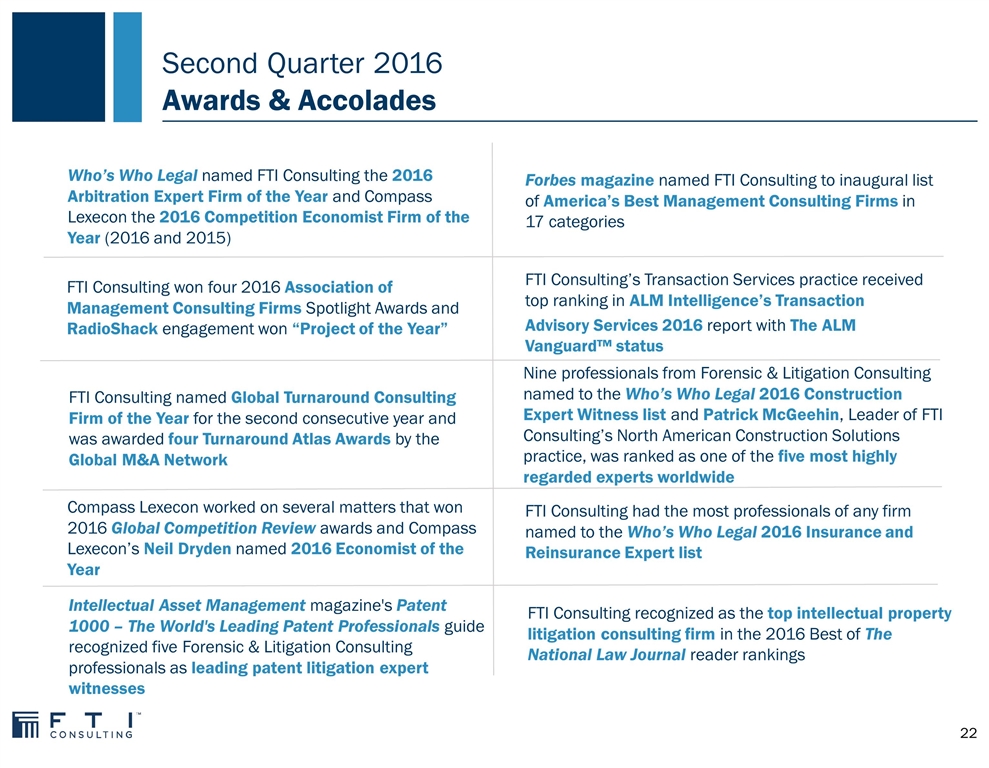
Second Quarter 2016 Awards & Accolades FTI Consulting recognized as the top intellectual property litigation consulting firm in the 2016 Best of The National Law Journal reader rankings Intellectual Asset Management magazine's Patent 1000 – The World's Leading Patent Professionals guide recognized five Forensic & Litigation Consulting professionals as leading patent litigation expert witnesses FTI Consulting named Global Turnaround Consulting Firm of the Year for the second consecutive year and was awarded four Turnaround Atlas Awards by the Global M&A Network FTI Consulting had the most professionals of any firm named to the Who’s Who Legal 2016 Insurance and Reinsurance Expert list Who’s Who Legal named FTI Consulting the 2016 Arbitration Expert Firm of the Year and Compass Lexecon the 2016 Competition Economist Firm of the Year (2016 and 2015) Compass Lexecon worked on several matters that won 2016 Global Competition Review awards and Compass Lexecon’s Neil Dryden named 2016 Economist of the Year FTI Consulting’s Transaction Services practice received top ranking in ALM Intelligence’s Transaction Advisory Services 2016 report with The ALM Vanguard™ status Nine professionals from Forensic & Litigation Consulting named to the Who’s Who Legal 2016 Construction Expert Witness list and Patrick McGeehin, Leader of FTI Consulting’s North American Construction Solutions practice, was ranked as one of the five most highly regarded experts worldwide Forbes magazine named FTI Consulting to inaugural list of America’s Best Management Consulting Firms in 17 categories FTI Consulting won four 2016 Association of Management Consulting Firms Spotlight Awards and RadioShack engagement won “Project of the Year”

